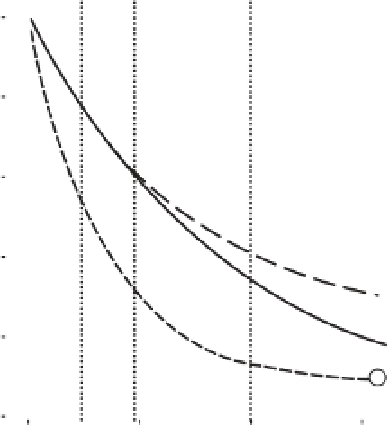Geoscience Reference
In-Depth Information
but 62% of 39 taxa were still present in the mildly
acidic sites (reduction of 0.27 pH units). In contrast,
the pattern of diversity loss with pH was similar for
non-calcifying fauna and algae. Although this sys-
tem and other natural CO
2
venting sites do not com-
pletely mimic the scale and effects of global ocean
acidii cation, they are strong indicators of its poten-
tial effects on biodiversity and ecosystem function,
as well as natural laboratories that complement
other efforts to understand the effects of a changing
ocean.
100
80
60
40
20
10.7
Implications of biodiversity loss
Although studies available to date do not provide a
clear picture of future changes in ecosystem func-
tion due to ocean acidii cation, much evidence sug-
gests that ocean acidii cation could have increasingly
profound effects in several marine ecosystems (coral
reefs, deep-sea systems, high-latitude systems),
particularly in combination with other anthropo-
genic environmental changes. Some reshufl ing of
dominance in phytoplankton communities appears
likely, but it is still not known if the long-term effects
of higher ocean CO
2
levels will cause a decrease or
increase in primary production (see Chapter 6). If
key species in intermediate trophic levels (e.g. the-
cosomatous pteropods) are affected either posi-
tively or negatively by ocean acidii cation, food
webs may be destabilized to some extent, perhaps
altering the path and efi ciency of energy transfer to
upper trophic levels. If biodiversity is reduced
within food webs, it is expected that the productiv-
ity and predictability of i sheries will be reduced
( Worm
et al.
2006). It is also possible, however, that
a simpler food web structure and potentially higher
primary production will enable greater trophic
transfer from the base to the top of food webs,
thereby increasing i sheries yields.
Changes in biodiversity could have important
effects on ecosystem services for society, with the
greatest impacts being on island nations which rely
heavily on seafood harvests and have less opportu-
nity for agriculture (Cooley
et al.
2009 ). Expected
declines in coral reefs will affect coastal i sheries
as well as tourism, an economic base for many tropi-
cal island nations. Reduced calcii cation, growth, and
survival of calcifying organisms, especially molluscs,
0
0.0
1.0
pH reduction (units)
0.5
1.5
Figure 10.3
Change in diversity as a function of pH reduction for
organisms living near the Ischia CO
2
vents. The biodiversity remaining (per
cent of taxa that occur in areas with no pH reduction, open square) is
shown for calcifying taxa (51 taxa total, white circles) and non-calcifying
taxa (71 taxa total, black circles). Atmospheric p CO
2
levels (ppmv CO
2
) that
would be required to cause pH changes in ocean surface waters equivalent
to those observed at three locations along the pH gradient at Ischia are
indicated by dotted vertical lines. For calcii ers (short dashed curve),
non-calcii ers (long dashed curve), and all taxa combined (solid curve, data
not shown), exponential regressions explained 99%, 90%, and 88% of the
variance, respectively. Fitted regressions indicate a loss of biodiversity of
~40% for non-calcii ers and all taxa, and ~70% for calcii ers, for a pH
reduction corresponding to the atmospheric p CO
2
level expected by 2100.
Data from Hall-Spencer et al . ( 2008 ).
chemistry at this site. CO
2
mixes as it is advected
downstream to produce a spatial gradient in ocean
pH from normal (pH
T
~8.2) to acidic (pH
T
~6.6).
Hall-Spencer
et al.
( 2008 ) documented patterns of
species richness at sites along the pH gradient cre-
ated by the venting CO
2
, i nding a general decrease
in biodiversity with pH for all l oral and faunal taxa
examined. Over all taxa, biodiversity declined
exponentially with pH (
R
2
= 0.88;
P
< 0.001), with a
slope indicating a 65% loss in taxa richness for a 1
unit decrease in pH (Fig. 10.3). Taxa richness for cal-
cii ers declined more rapidly with pH than non-
calcifying taxa with a ~60% loss of species under a
~0.5 unit pH reduction. Of 12 calcifying algal taxa,
10 were lost with just a 0.27 unit pH reduction, and
none were present in the lower-pH sites. Calcifying
animals were also less diverse in lower-pH areas,







